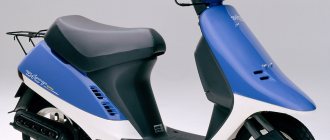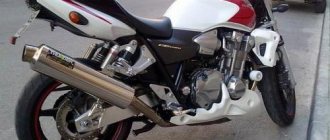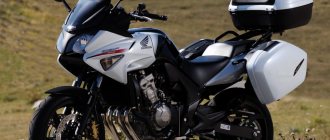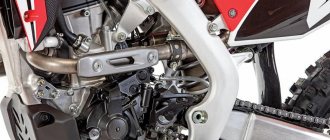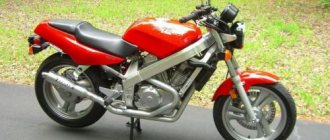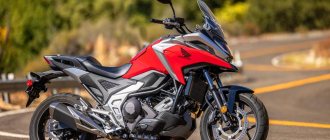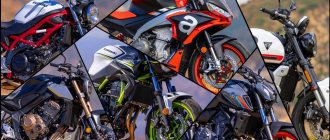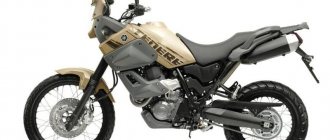Honda Super Dio: second generation
The second generation of Dio, which received the indexes AF-27 and AF-28, as well as the prefix “Super” to the name, began to be produced in 1990.
If you look at it, the 2nd generation model did not receive any technical changes; mainly engineers and designers worked on the appearance and ergonomics so that their scooter would not lag behind competitors from Yamaha and Suzuki.
They decided not to abandon the AF18E engine, especially since it has proven itself to be reliable and trouble-free. The engineers just “conjured” the settings, increasing the power in the base to 6.8 hp.
The scooter was produced in three main modifications:
- Super Dio AF-27 is the base model with drum brakes on all wheels;
- Super Dio AF-28 SR is a more expensive and prestigious modification, distinguished by a modified engine with increased power and a front disc brake;
- Super Dio AF-28 ZX - the most expensive version, in fact, the same SR, only with a spoiler instead of a rear trunk, and in a brighter color scheme.
Although production of the third generation began in 1994, the Dio AF-27/AF-28 model was mass produced until 1996, and then until 1999 in small-scale modifications with deep restalling.
Features, advantages and disadvantages
Until now, the Honda Dio AF-27/AF-28 model is considered one of the most popular in Russia, second only to the third generation modification. The secret of popularity is simple - low price on the used market, reliability, conditional availability of spare parts, high maintainability.
Apart from appearance, technically the scooter has hardly changed - having inherited, in this regard, all the advantages of the first generation model.
The AF18E engine, already tested in the previous generation of the model, was modified to increase power. This was achieved by changing the diameter of the crankshaft. The maximum speed of the scooter is electronically limited to 60 km/h, although there is enough power reserve to accelerate the vehicle to 70 km/h.
The maximum speed limit is made not only because of the peculiarities of the legislation - if you do not turn the engine to the maximum, it will last longer. If desired, the power limiter can be removed; on the AF-27/AF-28 model, this will require replacing the switch.
The engine runs great on 92 gasoline, although it is best to fill it with 95. Fuel consumption is about 2.5 liters per 100 km.
External changes to the Honda Super Dio have made it possible to increase the usable volume of the underseat luggage compartment. There is a special pocket on the front for various small items. The AF-28 ZX model has a more aggressive design, bright colors and the presence of a stylish spoiler with a brake light instead of a rear luggage platform.
This scooter can be used not only in the city, but also in rural areas - as thousands of owners confirm. Despite the “city” ground clearance, the main components of the scooter are protected from damage - all impacts are absorbed by the footrest and bottom. Of course, this is not very pleasant and does not always pass without consequences for the scooter, but the muffler and engine usually remain unharmed.
In terms of chassis, the AF-27 and AF-28 are no different from the previous AF-18 and AF-25 - they still have the same telescopic fork at the front and a monoshock absorber at the rear.
You need to understand that most scooters are designed specifically for urban use, so it is advisable to prepare them for rural areas - change the shock absorbers, fill the fork with high-viscosity oil, and install more “evil” tires.
In general, if you need a scooter specifically for rural areas, then it is better to pay attention to the “Tact” model, and if you increase your budget a little, then you can look towards the “Lida”.
Getting spare parts for the Honda Dio AF27/AF28 is not a problem, although if you need a high-quality original, you will have to wait for it (mostly Chinese spare parts are available).
The AF18E engine is loved for its highest maintainability, where, thanks to the vertical arrangement of the cylinder, all work on the piston group can be carried out without removing the engine.
Characteristics of Super Dio
- engine – AF18E (two-stroke with a displacement of 49 cm³ and a power of 6.8 hp for the base model);
- cooling – air;
- gas tank volume – 5 liters;
- oil tank volume – 1.2 liters;
- front suspension – telescopic;
- rear suspension - pendulum;
- front brake type – drum (AF-27) or disc (AF-28);
- rear brake type – drum;
- base – 1145 mm;
- length – 1640 mm;
- ground clearance - 100 mm;
- total weight – 66 kg.
The second generation Honda Dio, with proper care, will last for a very long time. The main thing is to initially find a decent and well-maintained copy.
Tags
50 cc scooters
Hi all. I have long wanted to register at a bikepost, since over the years of my two-wheeled life I have accumulated a lot of all sorts of articles on various motorcycle topics. They were published from time to time on the club forum. I always wanted to put them together and share them with my motorcycle bros. I think it would be fair to make the first post about my first bike. Keeping with the chronology, so to speak, the first personal two-wheeled horse is like first love. That girl from the class could also be very far from ideal, but she will be remembered for the rest of her life.
I have long wanted to register at a bikepost, since over the years of my two-wheeled life I have accumulated a lot of all sorts of articles on various motorcycle topics. They were published from time to time on the club forum. I always wanted to put them together and share them with my motorcycle bros. I think it would be fair to make the first post about my first bike. Keeping with the chronology, so to speak, the first personal two-wheeled horse is like first love. That girl from the class could also be very far from ideal, but she will be remembered for the rest of her life.
I bought that scooter absolutely spontaneously: long before that, I somehow learned to drive a rented scooter on vacation in Turkey. The vacation was over, but as it turned out, the motor virus was already in my blood. It didn’t show itself in any way for almost two years, until the moment when one summer, out of nothing to do, I climbed onto Auto.ru. Then I was only interested in cars, but the curve somehow brought me into the motorcycle section. Since in Turkey I drove the Honda Bali most of all and liked it, then I accidentally and naturally ended up in the sales section of Honda scooters. At the end of the aimless web surfing of that day, I came across an advertisement for the sale of a slightly tattered (cracked front shield and worn plastic on the sides) yellow Honda Dio. For only 13,000 rubles. I remember how I read a short ad to the end and a second later I was covered by a bright, bright flash-back that summer, when my then future wife and I were carefree riding along the mountain serpentine on a scooter, the flow of oncoming air cooled the skin heated by the bright southern sun, the smells pine needles, the sea and its perfume, mixed with another subtle smell... The characteristic smell of the exhaust of a two-stroke scooter engine... A measly 13 pieces to experience it all again?! I pushed off the computer table with my feet and the office chair on wheels rolled me to the table where the mobile phone was lying... I agreed, arrived by car, made an uncertain test ride of 50 meters for the sake of formality, then with the “chassis extended” I turned around in a huge arc and returned to I resolutely declared to the seller, “I’ll take it!” The scooter was thrown into the trunk, taken to the house, unloaded from the trunk with hellish labor and, with no less hellish labor, lifted to my floor in the elevator, rolled into the apartment and parked on the balcony. This is how I became the owner of my first motorbike.
But this article is about the scooter, and not about our relationship with it. It's time to finish this snot and drool and write, in fact, about the device. The first generation of the scooter (AF-18\AF-25) was born in January 1988 and almost immediately became popular. The budget, small, maneuverable scooter ran parallel to the Tact line, but was always positioned by Honda as more youthful and sporty. Front telescopic fork with hydraulics, disc brakes and a boosted engine in some versions, a sportier and more aggressive design.
The model was quite successful for its time; the design, ease of layout and reliability ensured high demand for the debutant. DIO was produced in two versions: with a drum (AF-18) and a disc (AF-25 SR - since 1990) front brake. There were also limited versions of the Dio SP, which differed from the regular AF-18 in different colors and a different instrument panel design. The second generation Super Dio (AF-27/28) was introduced in 1990. The new model has grown slightly in size, acquired a pocket under the steering wheel, and the number of configurations sold has increased. The simplest - the basic Super Dio was equipped with drum brakes, the SR version (AF-28) - with a disc brake and a boosted engine, the ZX - a sports package, including a boosted engine, a disc brake, a spoiler with an LED brake light, designed as a rear turbo casing trunk and another muffler, XR Baja is a stylistic nod to the iconic off-road bike Honda XR250 Baja, equipped with a disc brake, original optics, dashboard and wind protection for hands. Also, for the Japanese market, even then (!), electric versions of this generation of Dio were produced with rechargeable batteries instead of a gas tank and charging from an outlet. The second generation Dio was discontinued in 1996, but for some time this model was produced under the name Dio Fit and differed from the regular AF-27 in a completely redesigned plastic lining and optics. I want to talk specifically about the second generation of the scooter. I, no less, got the most charged version - the aforementioned DIO AF28 ZX.
The scooter is really quite dynamic for a fifty-kopeck scooter - it’s probably the fastest of the old Japanese “honest” fifty-kopeck scooters that I’ve ridden. The engine produces 7 hp, and the car weighs only 65 kg. The scooter even had a real slight pick-up at medium speeds, typical of more serious equipment. The scooter confidently accelerated to 60+, driving the speedometer needle beyond the marked zone. The caring previous owner had already messed around with the switch, so the maximum speed of the scooter was frankly pleasing. The Navitel Navigator GPS program has a function for viewing the maximum speed achieved during a trip. For me it was 68 km/h with 9 gram weights of the variator. Moreover, there were no special hills on the way, I hit in a straight line.
The downside of this whole upgrade is that a 5 liter tank of AI95 gasoline with the handle fully open was only enough for 120-130 kilometers. The suspension pleased with its stability in corners. The same Tact with its lever fork corners much more nervously. However, breaking through the front shock absorbers even on a small obstacle is a piece of cake. The front shock absorbers are generally a recognized problem with this scooter. There are no relatives on the market, and affordable Taiwan does not last long. There is no dust-proof corrugation on the shock absorber rod, which may be why in our conditions the unit dies indecently quickly. Small and thin 10” wheels are also designed only for ideal asphalt, which even Moscow roads cannot boast of everywhere. The rear shock absorber did not cause any problems and worked without breakdowns, however, I was quite light in weight, and the shock absorber was tuned. The brakes - front disc and rear drum were good for an old 50 cc unit, the front one was very tenacious and had good feedback. The rear one was just there and just worked.
The machine pleased with its reliability and repairability. There is no need to remove any trims at all to get to the air filter, spark plug and carburetor.
The Honda Giorno, for example, cannot boast of this. The scooter always started. Not the first time and not with the electric starter, but I started it with a kick even at -10. On the one hand, kicking for a long time was annoying, on the other hand, I knew that the animal would eventually start anyway, regardless of the weather. And such confidence in her technique gives rise to warm feelings for her. And the scooter was, according to the codes on the inside of the lining, 1994. Not new at all. The reliability of the scooter even inspired me to take an adventure - the first long-distance trip of 200 km in my life. 
Of course, the half tosses of those times were, in principle, too small. But I felt comfortable on it, even in touring motorcycle boots. There are footrests and it is possible to sit with your legs extended forward. Steering is also easier this way; by increasing the pressure of your foot on the footrest in the direction of the turn, you can slightly reduce its radius. The seat cushion is one and a half and there is room to move back. The legs, of course, are pressed close to the back of the front shield, but the steering wheel does not touch anything. The dimensions of the saddle, theoretically, allow two people to ride. But the rear passenger is very unhappy. He has absolutely nowhere to put his feet. There are no footrests for the passenger, and a hot muffler crackles invigoratingly next to his right foot. It's fun for the pilot too - the scooter itself is light and the handling character with two passengers changes a lot. The braking distance almost doubles, and the dynamics drop. The passenger is shifted very far back, so when you suddenly open the gas (especially on a hill), there is a high chance that the scooter will lift the front wheel and simply jump out from under you. In short, the device is purely single-seat.
Small dimensions also have a second side to the coin. As I already told you before, at first the scooter lived on the balcony of the apartment and for rides I lowered it on a regular (not freight) elevator. The scooter rolled into the elevator and rested its front wheel against its wall. climbed onto the rear wheel, the rear brake was blocked. So they descended vertically. I also often transported it in the trunk of my hatchback, where it fit perfectly if the rear seats of the car were folded down.
The situation with luggage containers is also quite good. A size S integral helmet fit into the toilet. The seat lid closed with force, but it closed. The battery is located there, under the saddle. High at the back, closer to the lock mechanism, it is covered with a casing with a recess. It was convenient to put spare spark plugs or fuses there. The trunk is well organized, roomy and well profiled. On the front shield, in addition to the cute and traditional for old Japanese bag hook, there is an open pocket. It is not covered with anything, but has drainage holes in case of rain. The pocket is quite roomy and two 0.33l bottles can easily fit in there. The pocket is convenient because it is located directly in front of the pilot and is open. You can throw a rag in there and wipe, for example, the visor of a helmet at a traffic light. The cargo capabilities of the sporty scooter are not limited to this: the front shield is secured with three bolts. A front luggage basket was produced for the model - these three bolts were unscrewed, and the basket fastenings were screwed in instead. At one time I went shopping like this - taking into account the remaining luggage capacity, I could easily bring a week's supply of food for one person at a time. True, the scooter looked pretty funny with it. It’s not for nothing that people aptly nicknamed scooters with baskets “beggars.” The oil tank cover is covered with a body-color decorative panel on hinges and is located not under the saddle, but slightly behind, between the saddle and the trunk. The gas tank cap is located near the floor, at the base of the saddle, closed with a door on the key. On the one hand, bending over to the fuel tray at a gas station is inconvenient, on the other hand, there is no need to open the seat and spilled gasoline (very often happens on half-trucks with their narrow necks with a jumper) flows off the floor and does not flood things in the underseat glove compartment.
The instrument panel, as is often the case on Honda scooters, is simple, but convenient and informative. It is dominated by a large speedometer; there is also a fuel gauge, a low oil level warning light, a speed light, a turn signal indicator, and an odometer. Everything is illuminated with a yellow light bulb. All indicators are perfectly readable, you just need to take a quick glance at the tidy. Naked functionality, not spoiled by design delights. In my case, the tidy had a hint of sportiness: the background of the instruments was white, the numbers were red. Charged version, right?
The design of the scooter, although hopelessly outdated, is quite harmonious. And the narrow headlight with integrated turn signals, mounted on the steering wheel, still looks relatively modern.
There are interesting recesses in the plastic on the sides under the saddle. They highlight the lines of the scooter and are functional. You can also grab the scooter by them if you need to move it a little while parking in a cramped garage, for example. The rear lighting equipment is also made in a single, albeit separate, unit - side lights, brake lights and turn signals on the sides.
The ZX version has a spoiler with an additional bright LED brake light.
In those days, it was probably very modern. Moreover, the spoiler does not prevent you from grasping the trunk from below when placing it on the center stand (By the way, there are two footrests on a scooter. There is also a side one). Well, removing the spoiler is a matter of a couple of minutes. In this case, we will have access to a full-fledged rear trunk, as on other AF 27 models. Naturally, the very first two-wheeled vehicle could not help but undergo sloppy tuning. So I first covered it with stickers that masked paintwork defects, then I stuck a chrome Honda emblem on the shield (at that time I didn’t suspect that the Honda motorcycle division had a completely different emblem), then I played with the weights. I put 7 grams against the usual 9 and was pleased. The maximum speed dropped by a couple of km/h, but acceleration from the bottom became a little more vigorous. Next I turned on the audio system. It was with that Dio that I came to the idea that a scooter without an audio system is not a full-fledged device at all. A two-channel Mystery car amplifier with a power of 60w was attached to the inside of the seat cover.
I mounted two 100-watt HYUNDAY speakers in my front pocket. There they stood quite well and the sound came from below, right under the helmet, in the chin area. An MP3 player was used as the head unit, which was attached to the same bag hook. The amplifier's on/off button was embedded in the same front pocket.
The speakers were not waterproof, but they were carefully covered on top with a piece of black leather from rain and storms. Despite the collective farm design, the system produced a loud, not disgraceful sound, and I often observed pedestrians at traffic lights trying to understand what was its source. My baby was the last one to be suspected. The apogee was the repainting of the scooter to match the color of the car (also often found among car enthusiasts who initially come to the motorcycle theme). It turned out well, but unfortunately I almost never drove in this color - the desire to have cubic capacity along with the received category A suddenly became unbearable and a Honda Foresight 250SE appeared in my garage. Dio was successfully sold within a week for 22,000 (!) without music. High liquidity in the secondary market is another strong point of this model. In general, “a million lemmings can’t be wrong”, the Dio model is absolutely deservedly popular in our market. I don’t know what else you can buy here for that kind of money with such a price/quality ratio. The compactness of the device can also be critical in some situations. I fondly remember my first scooter and am glad that I had such a worthy model in my garage...
Review of Honda Dio AF 28 SR/ZX (1992)
I got sick in 2009 and wanted a 2-wheeled friend. I didn’t have a category “A” license, but I wanted to ride. Simple conclusions suggested that we should take 49cm. An advertisement for the sale of a Honda Dio AF-28ZX scooter just caught my eye, I think it was 1992, I don’t remember exactly now. Of course, having read all sorts of information about them on the Internet, I was mentally prepared to purchase a moped.
In my eight, I went to buy it in the private sector on the outskirts of Samara. It was March outside, the snow was slowly melting, and I logically figured that I would just get it over before the start of the season. Upon inspection, it turned out that the battery was low, the unit would not start from the kickstarter, but according to the owner, everything was fine with it, he just hadn’t used it for a long time. In fact, later this turned out to be true. The price was also captivating - only 12 thousand rubles. In general, we pushed him into the eight of us with grief, and I moved in the opposite direction.
The next morning, together with a friend, they pulled him out and put him on the ground. While he was resting in the car at night, gasoline and oil leaked out of him through the necks of the containers that were not tightly closed. It didn’t start for a long time, but this time it grabbed hold and purred vigorously. I would be as happy as a child at this moment =) After driving around a bit in areas where the snow had melted (it’s basically impossible to start in the snow, these things are not designed for driving on snow), I dragged him into the apartment (luckily 2nd floor) right into the hallway. This is where the first research began.
I bought a new battery at the nearest motorcycle and bicycle goods store. At the same time I also purchased 2T oil. I bought a specially corrugated hose for the exhaust wires so that I could run it right in the apartment. Very cool, by the way - I tied one end of the hose with electrical tape to the exhaust pipe, which is at the end of the silencer, and threw the other through the kitchen window into the street =) The plan was to slowly go through it all - to see what was where and how, to make sure the reliability of the design, and well etc. As you already understand, I not only wanted to ride it, but also to disassemble and reassemble it. It was during this process that I personally encountered Japanese quality for the first time in my life. The most striking indicator was the carburetor. From the outside, it looked like a terrible lump of dirt, which would seem to be incompatible with the concept of a carburetor. However, when I opened it, I was shocked - everything inside was shiny as if it had come from the factory. After the AvtoVAZ dumps, where even a new carburetor turned into a garbage container after 2 weeks, it was incredible. I’m not embellishing—everything there really sparkled with newness and there wasn’t even a hint of dirt. Realizing my mistake in getting into it at all, I tried to quickly close it, do it as it was and not think about it anymore =) The variator was also in decent condition, although the belt was a little worn, there was still enough time before replacement in reserve. By the way, I ordered spare parts through the Internet in Moscow, but it was possible cheaper directly from Vladik. From Moscow, of course, it was faster, so the first option suited me quite well.
In general, I completely disassembled this moped using a screwdriver and a pair of keys in the hallway in literally 2 hours (after fiddling with VAZ crafts, this was perceived as entertainment). I cleaned it of dirt and dust and wiped the contacts. I put it back together for about the same amount, having figured out for myself what needed to be changed. It was necessary to change the plastic speedometer drive gear, the front and rear shock absorbers, and, in the future, the variator belt. I ordered two gears at once (one as a spare), because I was afraid of its plastic unreliability. The Japanese couldn't have installed a metal one? One could forget about her forever. I also didn’t like that the low beam was constantly on, so I used a brand new illuminated button from a VAZ-2114 with a picture of a PT headlight. It was nice and quite on topic =) I replaced the shock absorbers a little later, replacing the rear one gave a good increase in ground clearance, perfect for our roads!
In general, such a small device was surprising in the number of functions. Here you have an electric starter (the moped starts easily with a button), and low beam + high beam, turn signals, stop lights, fuel gauge + speedometer, signal, signaling with auto start. A real toy for adults. It is unlikely that a teenager who has never started a penny from a crooked starter would appreciate all this. So my feelings are quite understandable - I was drawn to the unit. By the beginning of dry weather, when I started riding it, one more thing surprised me - its power. Weighing 70 kg. it had 7 hp. You have to feel it. All sorts of Chinese stealth vehicles, with more weight, have half the power, and it is more than enough. And here you can imagine how the scooter literally flies out from under you.
Let's move on to driving, which immediately revealed the main problem - operation is difficult due to shitty roads and a small wheel radius. I couldn’t fix either the first or the second, and it was depressing. Anyone who has been to Samara knows that there are simply no roads here. I didn’t need to drive on the main more or less smooth roads, but on many others it was a bit difficult. Another point is the movement itself. In Samara it is almost chaotic, akin to the Brownian movement of particles, and if you spend a lot of nerves on a car, then on a small unstable unit that can easily roll over if it moves suddenly, you spend them 100 times more. So I tried to enjoy riding a scooter either at night or early Sunday morning, when everyone was sleeping. It is then that you feel the beauty of traveling on a 2-wheeled vehicle. The summer breeze blows over you, no seats, windows or hoods prevent you from feeling free. The sensations are approximately the same as those you experience when you get behind the wheel for the first time. I don’t know how the suicide bombers get these mopeds up to 100 km/h, but 30 was enough for me to feel nirvana. Sitting like on a stool and the absence of any protection other than a helmet all the time hinted that if something went wrong, then everything would be much worse than on a motorcycle. In fact, accelerating such a scooter to 100 is not a very trivial task, but you have to be a completely frostbitten idiot to risk riding a scooter at such a speed. I would not advise anyone to accelerate over 40-50. If an unfortunate pebble suddenly gets under your front wheel, you are almost guaranteed to end up in either a hospital or a morgue (depending on the traffic volume on the road). Therefore, I am entirely in favor of category “A” rights at 49 cm. For me, a car enthusiast with 5 years of experience at that time, it was really scary to drive it even at 40.
Giving children rights to these vehicles is only after many hours of watching scooters scattered on the roads. What can I say, a 16-year-old teenager does not understand all the dangers of such a vehicle, just as he does not know about assholes and blondes driving the cars around him. He also does not know that a pedestrian can jump out at any moment, and sharp braking on a scooter usually leads to a coup, which ends again, either in a hospital or in a morgue (if the coup is unsuccessful). In short, scooters should be sold to grown-up bearded guys. By the way, in the village such a unit is a real holiday. Fishing, mushroom picking, hanging out in a neighboring village - just what the doctor ordered. It has a spacious luggage compartment under the seat, there is an additional one under the steering wheel, and you can attach a basket in front. Super, in general.
Traveling on such a unit is very comfortable, apart from the disadvantages described above. You don’t need to switch anything, just turn the throttle and let’s go. The variator itself “increases” the gear, so to speak, and, by the way, is a fairly reliable and simple unit. In general, this whole Honda is a small, reliable car that will never let you down if you take care of it. 2T oil and gasoline are poured into different tanks, and the carburetor itself mixes everything as it should. Even if you come across a rickety scooter, if you have spare parts, completely rebuilding it is a task with a beer and half a day’s pleasure. One of the most important conditions for successful and trouble-free operation is well-functioning rear brakes. It doesn’t matter whether you have disc or drum ones, the most important thing is that they work at least as well as the front ones. Otherwise, you may not even leave the garage. Don’t even hope to keep the steering wheel level when braking with the front brake; you won’t even notice how you will roll over. You can’t even take sharp turns on such a moped - the result is still the same - a coup. Do everything smoothly and measuredly, this is the only way you will protect the integrity of your 2-wheeled friend.
And finally, about consumption and fuel. The tank holds something around 3-4 liters (I don’t remember), and according to my measurements, the consumption is about 2l/100km of good 92nd gasoline.
I sold it at the end of summer because... I drove around and wanted a larger wheel radius. I think that the family from the region who bought it never regretted it, because... it was completely taken care of by me and ready for long-term use.
